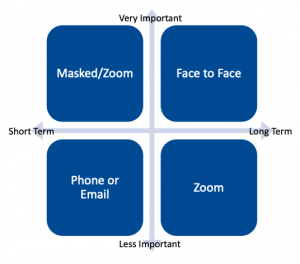
Your Donors, Sponsors, and Funders: Can You Keep Them or Get Them Back?
The most common questions my clients are asking now involve former and current donors, sponsors, and funders.
They want to know:
- If their new donors, sponsors, and funders will stay with them?
- And if yes, will they continue supporting them at their current level or better?
And:
- If their former donors, sponsors, and funders will return?
- And if they do, will they fund them at their former level or more?
You are probably asking the same questions. Your first answer may be that no one knows.
However, answering this way is likely to make you throw up your hands and turn to other priorities.
That would be a mistake.
While other people will make the final decision, you have lots of influence here. Your challenge is to decide upon and then focus on actions to maximize your chance of retaining and regaining these revenue streams.
The New Revenue Challenge
Deciding the best actions now, however, is more complex and confusing than ever. Your choices have proliferated, and the consequence of different options in terms of health risks adds more complications.
Although it is unrecognized in the nonprofit sector, the proliferation of options is as challenging as uncertain funding. (See How to Succeed Getting Nonprofit Corporate Sponsors and How to Grow Your Sponsorships Dollars for more about how to grow your sponsorship dollars.)
You might be thinking, ‘The proliferation of options is not more important than funding.’
It is because it stymies actions to generate it.
In the old days, like 2019, when you sought a meeting with a sponsor, you’d prefer a meeting in the sponsor’s office, accept a conference call, and settle for an email exchange. Now, you have no idea who is in the office, if they’re doing live meetings and a half dozen other issues. Moreover, it’s not just what your donors, sponsors, and funders do—your comfort level matters, too.
All these tactical unknowns and possibilities get in the way of taking strategic actions. The times call for new systems to prioritize your most precious resource–your people assets so that you continue to undertake as many of your strategic activities as possible. In the example above, the strategic activity is contacting a sponsor and offering them compelling value.
To obliterate these clouds of confusion, nonprofit leaders need tools to streamline tactical decisions.
A Decision Tool Example
 Look at this graphic developed for a client, discerning the type of meeting to seek and how she uses it.
Look at this graphic developed for a client, discerning the type of meeting to seek and how she uses it.
If the relationship is significant and long-term, she seeks face-to-face meetings. If the contact is vital and brief, she sets up coffee outdoors and wears a mask or, if the weather’s inclement, they set a Zoom call. For short-term relationships, it’s phone or email for short-term opportunities and Zoom for longer relationships.
This simple tool allows her to conquer her tactical confusion. She cannot know if her long-term sponsors, donor, or funder will continue their investments. However, by engaging them and learning their goals, she moves from uncertainty to familiar ground, sharing her nonprofit’s value.
Suppose you’re wondering if you’ll keep your current or regain your former revenue streams, act. Don’t just wait for others to decide your fate. Help them to see your value. (Here’s more about how to show your value: How Can You Increase Your Sponsors’ ROI? and Regain Your Lapsed and Waffling Sponsors.)
If you’re confused about seeking a face-to-face meeting, use the chart above. If other tactical issues are getting in the way, develop a tool that allows you to move forward.
Your future funding doesn’t only depend on them; it very much depends on you.
Do you have a colleague who is concerned about future funding? Please share this article with them.
For more answers, check out this Karen’s Nonprofit CEO Library.
For solutions delivered to your inbox, sign up for Karen’s CEO Solutions.
Karen Eber Davis is a nonprofit strategic planning consultant who works with visionary leaders committed to taking their organizations to new heights. She offers customized strategies, assessments, and coaching designed to help leaders lead their organizations to achieve their potential. She is the author of 7 Nonprofit Income Streams and Let's Raise Nonprofit Millions Together.
Categories
If you appreciate these Added Value posts, please consider subscribing.
Latest Posts
- How New Nonprofit CEOs Secure Board Buy-In for Strategic Planning
- How Nonprofit Leader Navigate Crisis with Clarity & Confidence
- One Way AI Can Help You Find a Path Where None Exists
- In Crisis? Resist Cutting Your Ability to Make Income
- Nonprofit Strategic Planning Assessment: 10 Questions to Strengthen Your Strategy
